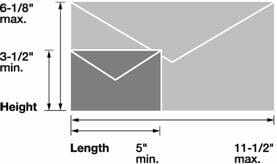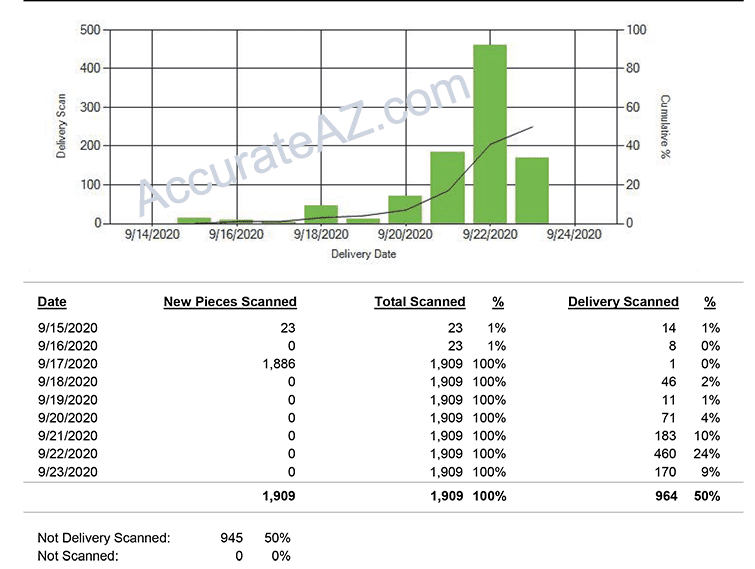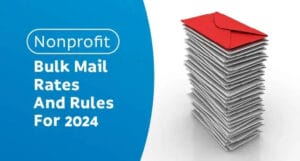Listen to This Audio to Get a Full Overview in Two Minutes
Over the last 4 months, we are asked every day "What's going on with Political Mail?"
As a mailing company or mail house, Political Candidates, Consultants, Campaign Managers, and others are very concerned about the USPS and its future.
Accurate Mailing Services mails for numerous Candidates, Politicians, ballot propositions, and PACs, so we feel it’s important to share common questions we are receiving, and our answers, to help Political Mailers from the perspective of a printing and mailing company during this unprecedented election cycle. A bit about us. Of the tens of thousands of mail processing companies in the USA, we are one of a few hundred mailing companies designated by the USPS as a Seamless status mailer.
Seamless status is a designation earned by the USPS for consistently producing high-quality and compliant mail. As a Seamless mailer, we have direct insight into the processing and delivery of mailings for our Clients. We also employ mail tracking tools and create USPS Informed Delivery campaigns for Clients adding digital marketing capabilities. Okay, so now you know a bit about us, let’s dig deeper into what’s happening in political mailings.
A brief discussion about USPS mail rate categories and political mail designation.
USPS Mail Rate Categories:
First-Class Mail
First-Class Mail is one of the primary mail rate categories provided by USPS. It is commonly used for personal and business correspondence, bills, invoices, and lightweight merchandise. This category offers a cost-effective solution for sending mail within the United States, including Puerto Rico, the U.S. Virgin Islands, and Guam. First-Class Mail is known for its quick delivery and includes features such as tracking, forwarding, and return services.
Priority Mail
Priority Mail is another popular mail rate category offered by USPS. It is designed for customers who require faster delivery times for their packages and documents. Priority Mail includes insurance coverage, tracking, and free package pickup from the sender’s location. This category is ideal for businesses that must ensure time-sensitive deliveries or for individuals requiring reliable and expedited shipping services.
Priority Mail Express
Priority Mail Express is USPS’s premium mail rate category, guaranteeing overnight or two-day delivery to most locations in the United States. This category provides customers with enhanced features such as money-back guarantees, free tracking, and 24/7 customer support. Priority Mail Express is the go-to choice for urgent and time-critical shipments, offering both senders and recipients convenience and peace of mind.
Media Mail
Media Mail is a specialized mail rate category that offers discounted shipping rates for educational materials, media, and other printed materials. Eligible items for Media Mail include books, manuscripts, DVDs, CDs, printed music, and educational charts. This category is affordable for students, educators, and businesses distributing educational and media-related content.
Retail Ground
Retail Ground, formerly Standard Post, is a mail rate category suitable for sending packages and oversized items that do not qualify for First-Class or Priority Mail. This category offers economical shipping options for individuals and businesses, allowing them to send larger and heavier packages at reasonable rates. Retail Ground may have longer delivery times than other categories due to its cost-effectiveness.
USPS Marketing Mail
USPS Marketing Mail is a mail rate category tailored for businesses and organizations engaged in direct mail advertising campaigns. It allows businesses to reach a broad audience by sending promotional materials, catalogs, flyers, and other advertising content. This category offers competitive pricing, making it an attractive choice for companies aiming to maximize their marketing efforts while minimizing expenses.
Political Mail Designation:
In addition to mail rate categories, USPS also provides a special designation for political direct mail. Direct mail political campaigns refer to any material mailed for political campaign purposes, including campaign literature, fundraising appeals, and voter registration information. This designation ensures that political direct mail receives specific processing and delivery standards to support the democratic process.
To qualify for the Political Mail designation, the mailpiece must meet specific requirements set by USPS. These requirements include proper identification of the sender, compliance with applicable postal regulations, and adherence to guidelines regarding content and format. The Political Mail designation promotes transparency and equal access to information during election campaigns.
The USPS defines political mail as “Political Mail may be sent from a Political candidate, federal, state or local campaign committee, or political party.” The majority of Political Mail falls into two rate classifications.
Letter size mail:

Flat-size mail:

Both letters and flats can be mailed by First Class or Marketing Mail (traditionally known as Bulk Mail). First Class mail postage is more expensive and delivery is faster. Marketing Mail is a lower postage rate and consequently the slowest delivery speed.
Political mail is a unique classification. It can be either letter or flat size, and when properly claimed and prepared by USPS rules, is considered First Class mail for processing and delivery. In other words, Political mail can be designated as Marketing Mail (lower postage and slower delivery) and get the benefits of first-class processing. Political Mail then moves to the front of the processing line, even ahead of first-class mail, to be processed as quickly as possible.
A list of common questions and our answers about Political Mailings.
Question: When do I need to mail to get in-home delivery on a specific date?
Answer: To ensure in-home delivery of a mail piece on a specific date, it is important to note that there is no guaranteed method. The United States Postal Service (USPS) processes Political Mail as First Class, but it is impossible to provide an exact delivery date due to various factors. It is advisable to be cautious of any letter shop or mailing company that claims to guarantee delivery dates.
Additionally, it’s essential to understand that only some of your mail will be delivered in-home on the same day. For example, if you send out 10,000 pieces of Local Mail, USPS tracking data shows that approximately 60% to 90% of those pieces can be delivered at the beginning of the in-home delivery cycle. The remaining mail is usually delivered over the following two days.
The image displays a real client tracking report with USPS data for a National campaign mailed at a Marketing Mail rate (not Political Mail). The “New Scanned Pieces” column indicates when the Post Office begins processing the mail on their sorting equipment. The “Delivery Scanned” column shows when the pieces have arrived at the Post Office responsible for delivery and have been scanned as out for delivery.
In the example, you can observe that 23 pieces were scanned on the 15th and delivered on the 16th and 17th. On the 16th, no mail was scanned, suggesting that the mail going to other states was in transit to their respective Post Offices. Then, on the 17th, 1,886 pieces were scanned. Despite the large number scanned, the in-home delivery of those 1,886 pieces occurred gradually from the 18th to the 23rd, according to the “Deliver Scanned” pieces and dates.
It’s important to note that 50% of the entire mailing is not showing in the “New Pieces Scanned” column. These pieces may be in limbo, meaning they still need to be delivered scanned but are still out for delivery. Alternatively, they may still need to be delivered scanned, necessitating further follow-up with the USPS to track their whereabouts.
In conclusion, mail delivery cannot be guaranteed for a specific date, and the in-home delivery of mail pieces typically occurs over a range of days rather than all on the same day.

This in-home delivery pattern is normal for Marketing Mail with lower postage and slower delivery. The USPS generally says that Marketing Mail, on a National level, can take up to 21 days to deliver. However, when we compare this data to a similar campaign in 2019, these numbers reflect a slower delivery time of approximately 1-2 days. Is the point of this to criticize the USPS, NO. Okay, so what is the point? The point is to demonstrate that Political Mail stakeholders will need to plan their campaigns accordingly for the targeted in-home date goals.
Question: When do we mail it if we don’t know the delivery date?
Answer: We have a few best practices that we follow to help work with you to get the desired in-home date. Without giving away our secret sauce, here are a few things to consider when planning your direct mail political campaigns. First, how many postcards or letters will you be mailing for this campaign? What geographical area are these being delivered to, a small area or across the USA? Will you want us to print and mail it, or do you have the mail printed already and just want us to mail it for you? When will the art files for printing be ready? Do you have an estimated postage amount you’ve budgeted for? These questions are just a few inputs required to work with clients to get the closest in-home date possible.
Question: What is the best size of political postcards to mail?
Answer: “Best” can be subjective, but we interpret it as two things. First, what size gets the most conversions, ultimately, votes? Second, what size gives you the best bang for the buck or cost? With these assumptions, these are the answers or questions we reply with. What is your budget? Are your political postcards already designed? Has the design been verified as a USPS Automation Compatible mailpiece? The 4 most common sizes we mail are:
- 5.5″ x 8.5″
- 6″ x 9″
- 6″ x 11″,
- 8.5″ x 11″
These four sizes cover about 85% of the Political Mail for political postcards we process, so this might be the short answer you are looking for.
Question: How soon can we get something printed and mailed?
Answer: This one can be a bit nerve-wracking as soon as it is asked. The two biggest inputs required to answer this question are budget and preparation. If you have a print-ready design art file and the mailing list, smaller quantities, 2500 – 100,000, can be printed digitally and mailed in one or two days. Digital printing is more expensive in higher quantities but is the best way for quantities under 25,000. If you do not have artwork ready or you need more than 100,000, plan on 3-5 days for printing and mail production. This does not include USPS processing and in-home delivery time.
Question: Is the stuff I hear about in the news about slower or unreliable delivery true?
Answer: Treading on a delicate subject here as I do not want this to become a hot-button issue, the short answer from our experience is yes. That said, our statistical analysis of the mail we have been producing and mailing shows a delay of about 1 to .75 days longer than the last election cycle, 2018. Presidential election cycles have more mail, so anticipating a delay is consistent with the increased volume in this election cycle. We recommend mailing one day before your target drop date (that day we deliver mail to the USPS).
Question: Can you provide political mailing lists?
Answer: Yes. This is the simplest question and answer but is more complex. Seasoned Political mailers have lists of sources that provide them with the exact criteria they seek. For example, one of the most common lists sought for a Political Mailing is a list of voters that have voted in the last several general elections and what party affiliation. Another example is a list provided by the municipality the election will occur in. These political mailing lists are very helpful to know who in the electorate has yet to mail in an early ballot so your campaign can target these voters. For some campaigns, party affiliation is less important than demographic information like age, gender, zip code, income, etc. Demographic lists are more common for local to hyper-local Propositions. Saturation lists, as the name sounds, you are mailing to every address on a postal carrier’s route, which can also be an option for specific campaign types.
Our observations and analysis over the last few months about mail processing and delivery yields interesting results. Disclaimer…what we are sharing is not clinical science, non-partisan, and not intended to be used for any purpose other than to inform Political Mail stakeholders what we have and are observing with the USPS.
Our Suggestions for Political Mailings:
- Local mail should be delivered to the USPS 2-4 days before your desired in-home date
- State mail should be delivered to the USPS 3-5 days before your desired in-home date.
- National mail should be segmented into geographical areas, with the mail that is furthest away delivered to the USPS first, deliver the midrange mail 1-3 days later, and local mail last. This strategy produces a closer in-home date for all the mail.
- Find out the EXACT date when the Absentee ballots in your election will be mailed to voters. You need to have your first Political Mailing planned to arrive just before (1-2 days) or just after (1-2 days) these ballots are mailed out. Elections can be decided within the first 10 days of Absentee voters receiving their ballot, so you must be in front of them with your mailing at this time.
- Know your audience. Study the voters diligently and discover their hot-button issues.
- Segment your voters into groups, if appropriate, by demographic, psychographic, geographic, or any other way you can to tailor your messaging to each group.
- Find a good printing and/or mailing company you feel comfortable with. Interview them by asking about years of experience and assessment of the current area where they typically deliver mail, and they are USPS Seamless mailers. Can they meet your goals? Do they want to work with you? What type of capabilities and capacities do they have?
- Can they help you respond quickly to last-minute hit pieces by the opposition? This is critical to your campaign success when the clock is ticking to November 7th.
- Some printing and mailing vendors have “spies” that can alert opposition to a hit piece being produced and will mail soon.
- Ask your mail house if they provide you the USPS Postal Receipt, a PS 3602 form, that documents the handoff from your mailing vendor to the USPS. It contains critical details such as the date mail was delivered to the USPS, the total number of mail pieces delivered, and the total postage cost for the mailing. This is a Legal document that a quality mailing company should provide any Client. Gone are the days of a mailer answering your “When did it mail?” question and never really knowing if the answer you receive is correct.
- Remember, after your mailing vendor delivers the mail to the USPS and the USPS accepts it, the in-home arrival time is not the mailer’s responsibility. Please be kind to your vendor if they did what your service level agreement (SLA) called for.
- Mail Tracking. Use a vendor that provides USPS mail tracking reports. This allows you to see updates on your Campaign as it progresses through the USPS system.
- Ask your printing and mailing vendors if they are doing any work for your opposition; you must be specific about the opposition, like Candidate names. Some will disclose this, and some will not. It is worth asking to decrease the chance that the opposition can be tipped off about your mailing without you knowing it.
Conclusion
Again, these are our recommendations, not a guarantee. So many factors influence delivery; you never know when the mail will be delivered. For example, we delivered local mail at Marketing Mail postage rate to the USPS, and it was in-home the next day. We have also delivered local mail, which was in-home in 5 days. State mail can follow a similar pattern. When planning state, or larger geographic mailing areas, discussing a plan with your mailing partner is critical. The USPS is taking more time to deliver mail this election cycle than in 2018. Statistically, the difference is slight and can be overcome by working closely with your mail house, especially Seamlessly qualified mailers. This was informative and helpful. Ballotpedia is a great resource for a general overview of what’s happening in Ballots and Voting.



